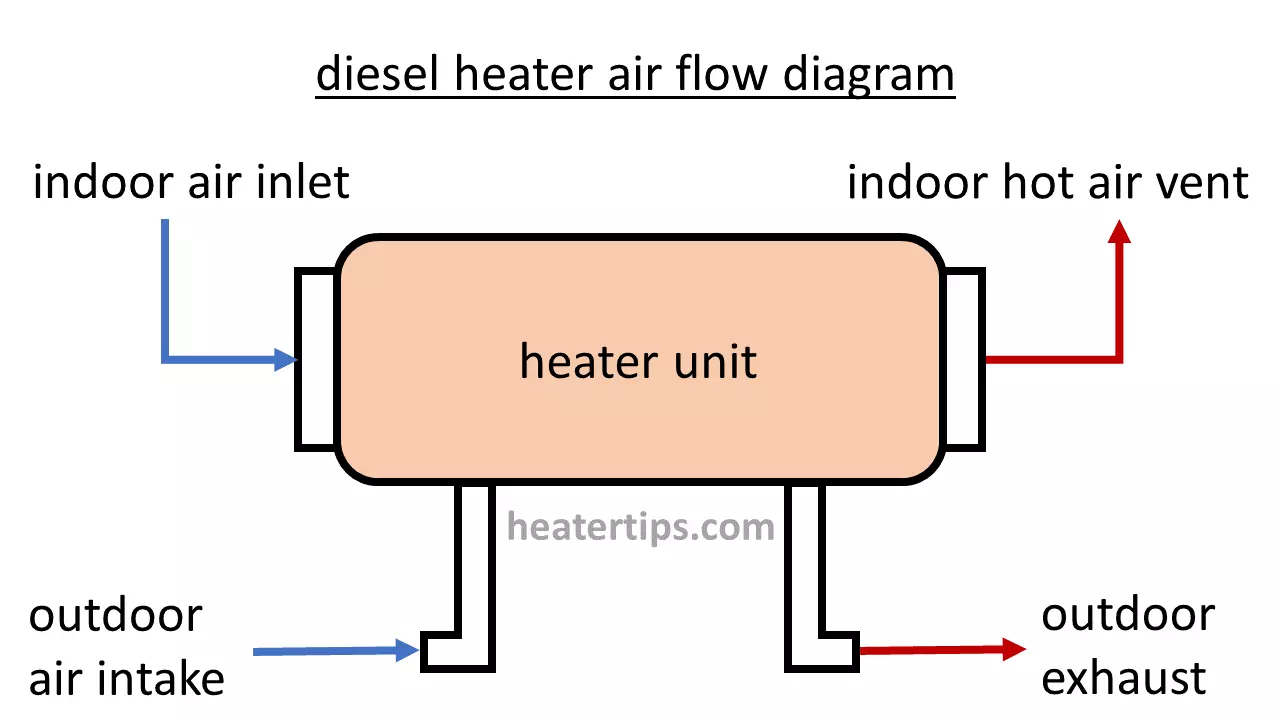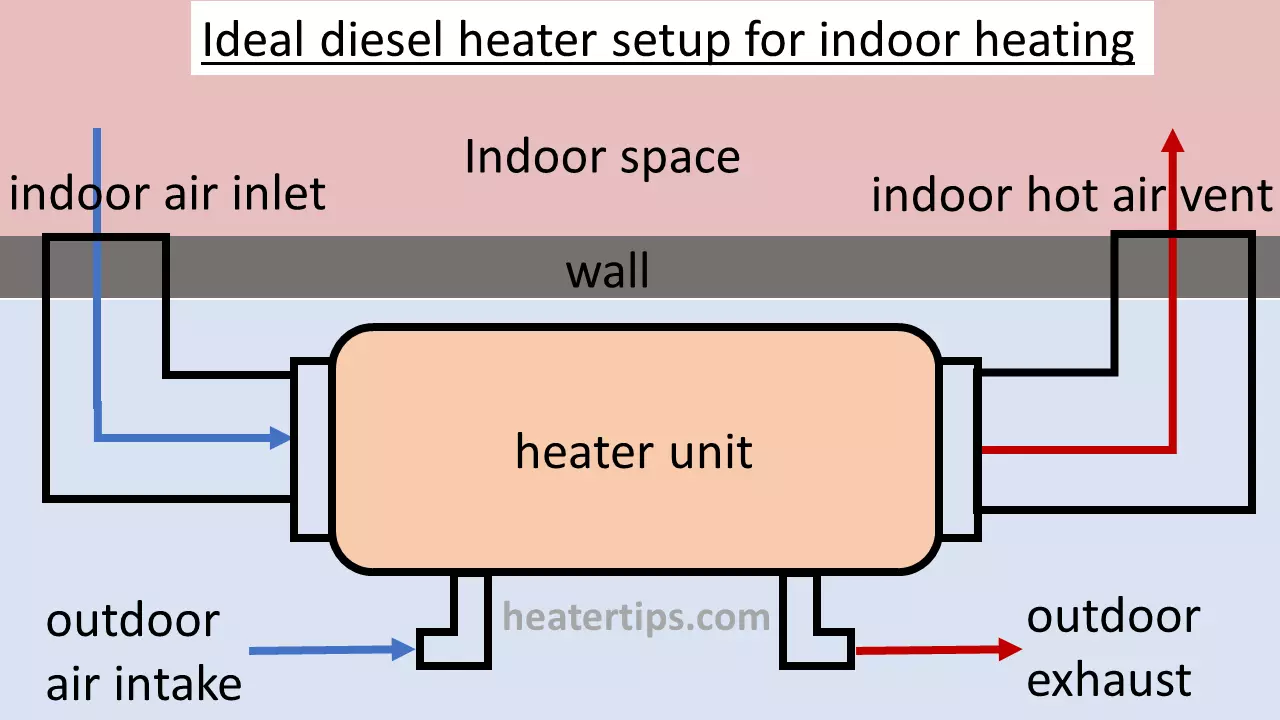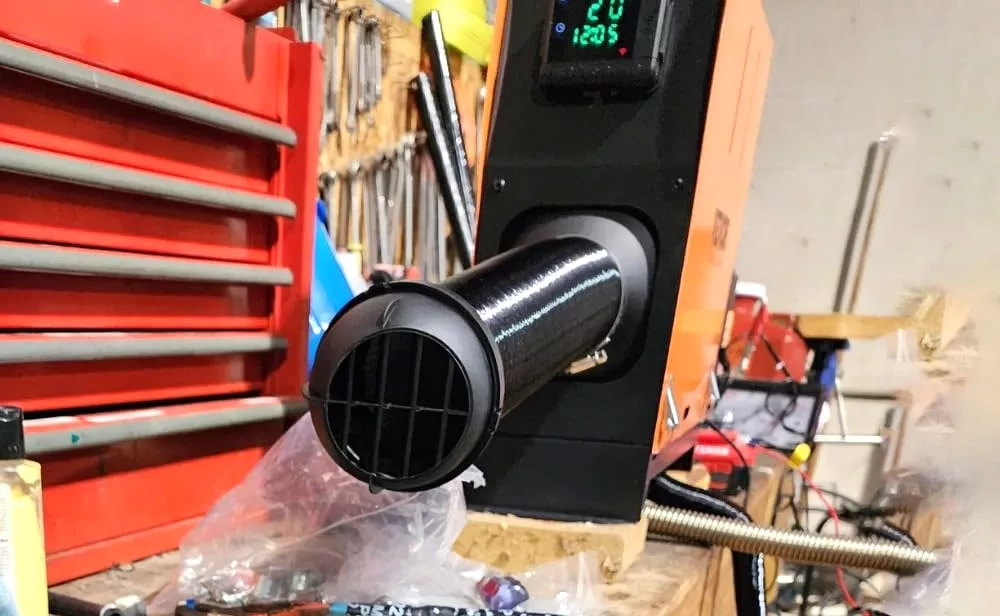You can use a diesel heater indoors, in your house, in a garage, shed, or workshop. All you need is a reliable, weatherproof diesel heater setup.
Diesel heaters can make great emergency heaters. With just a car battery and some diesel, you can heat your home in case of an electricity outage.
Or, for tiny houses or cabins, diesel heaters can even be reliable long-term heaters.
In this guide, we’re having a look at how to properly set up a diesel heater for indoor heating.
First, we’re going to have a look at the different parts of a diesel heater and where you should install them to heat your house. For that, we’re comparing inside and outside placements for the heater. One is clearly safer.
After that, we’re going to check out different sizes of diesel heaters and which best suits your home.
And lastly, we’re going to compare diesel heaters with gas heaters for indoor heating and see some of their shortcomings, but also their advantages!
So, let’s jump right in.
Which Parts of a Diesel Heater Are Always Indoors / Outdoors?
A newly packaged diesel heater comes with many different parts. For this article, we’ll focus on the most important ones that are critical for indoor heating.
The biggest part is the diesel heater itself. The diesel heater contains the electronic thermostat controls that monitor and adjust the burn rate. Also, it contains a fuel tank and a small fuel pump moving the diesel fuel between the tank and the combustion chamber.
A diesel heater has two main opening components: the hot air vent facing into the space you’re heating, and the exhaust side, which leads to exhaust fumes outdoors.
Actually, there are 4 openings, two for each of these sides.
Since the hot air vent blows hot air, it has to let in air from somewhere. That makes the (indoor) cold air inlet necessary. Just like a fan, one side sucks in air, the other side blows out air.
The hot air vent and the air inlet are always located indoors.
And since the exhaust blows fumes out, it has to suck in air as well. For that, there is an outdoor air intake pipe.
The exhaust and the air intake are always outdoors.

So, to sum this up:
The indoor vents (hot air vent and air inlet) and the outdoor exhaust (exhaust and air intake) are fixed in place. Or rather, their end is fixed. The hot air vent always has to be inside, while the exhaust opening always has to be outside.
The key question is now: Is it wiser to set up the diesel heater indoors and lay out pipes to lead the exhaust gases outside? Or is it better to set up the diesel heater outdoors and install pipes to lead the hot air vent inside?
We’ll answer this in the next section.
 A typical diesel heater setup: The hot air vent has a large hose attached that leads the air toward the space to be heated. The exhaust (metal pipe below the heater) leads outdoors.
A typical diesel heater setup: The hot air vent has a large hose attached that leads the air toward the space to be heated. The exhaust (metal pipe below the heater) leads outdoors.
Should the Diesel Heater be outside or inside?
Let’s have a look at the two different possible diesel heater setups for heating your house.
1. Diesel Heater Indoors / Exhaust Pipe Leads Fumes Outdoors
The first option is to have the diesel heater unit inside, with the exhaust and intake pipe connected to the outside. Essentially, this means that the diesel combustion takes place indoors and waste gases are led outdoors.
Advantages
- Energy efficiency: Since the combustion takes place indoors, there is little waste heat.
- Always weatherproof: The diesel heater standing indoors is always protected from weather and corrosion.
Disadvantages
- Unsafe diesel fumes: Diesel heaters are never 100% perfectly sealed. Exhaust fumes will leak, which can be very unpleasant and unhealthy. This can be acceptable in an imperfectly sealed place such as a garage or a workshop. But it is not suitable for heating a living space.
- Noise: The diesel heater will be noisy.
2. Diesel Heater Outdoors / Hot Air Vent Pipe Feeds Hot Air Indoors
The second possible setup for heating an indoor space with a diesel heater is to place the heater outdoors and connect the hot air vent via pipes to the indoors.
Advantages
- No fumes: If only the hot air vent connects to the indoors, you’ll get 100% clean, hot air.
- Reduced noise: With the diesel heater placed outdoors, there will be less noise.
Disadvantages
- Needs weatherproofing: You have to ensure the diesel heater is placed in a weatherproof place, under a roof, or in a box.
- Reduced energy efficiency: On the way through the hot air vent pipe, some heat is lost.
The only sustainable approach to indoor heating is, in my opinion, placing the diesel heater outdoors and feeding the hot air into the indoor space you want to heat.
This is the only way to completely avoid sealing issues that can lead to toxic fume emissions indoors. Place the source of unpleasant diesel fumes outdoors, and you have nothing to worry about.
Also, solving the weatherproofing and reduced energy efficiency (when the heater unit is placed outdoors) is easier than solving noise exposure and toxic gas leaks.
The ideal diesel heater setup for indoor heating is to place the diesel heater outside and feed the hot air indoors via pipes.
 This is the ideal setup for diesel heater indoor heating: Place the diesel heater outside. Connect the indoor hot air vent via a pipe to the space you want to heat. The air inlet also needs to be connected for maximum efficiency and to ensure the heater only blows clean air inside.
This is the ideal setup for diesel heater indoor heating: Place the diesel heater outside. Connect the indoor hot air vent via a pipe to the space you want to heat. The air inlet also needs to be connected for maximum efficiency and to ensure the heater only blows clean air inside.
How to Setup the Diesel Heater for Indoor Heating
Setting up the diesel heater can vary a lot depending on your individual situation and you might have to adapt some of the steps.
Here’s a step-by-step guide to help you through the process:
1. Choose the Location
Identify the ideal outdoor spot for your diesel heater. Look for areas like a porch or a shed close to your house. Ensure it’s easily accessible for maintenance and close enough to effectively heat your desired area. If your chosen spot is already sheltered from the elements, like a covered porch, you might not need additional weatherproofing.
2. Install Weatherproofing Measures
If the location isn’t naturally sheltered, protect your diesel heater with a weatherproof box or cover. Look for materials like heavy-duty plastic or rust-resistant metal. Ensure the cover has proper ventilation to avoid overheating.
One box you can use is this Rubbermaid outdoor storage box. It should be more than large enough to fit most diesel heaters.
3. Connect the Heater to the Power Source
Securely connect your heater to a power source. For portable use, a high-capacity car battery is suitable. If available, opt for a dedicated electrical connection. Ensure the power source is stable and has the appropriate voltage and amperage for your heater.
4. Install Exhaust and Air Intake Pipes
Use high-temperature resistant pipes for the exhaust, such as stainless steel or aluminum. Attach the exhaust pipe securely to the heater, leading it outdoors.
Of course, that is only necessary if the heater is inside a box or a shed. If you place the heater on the porch, there’s no need for an exhaust pipe.
For the air intake, use a pipe that’s durable and weather-resistant. Ensure both pipes are well-secured and free from any bends or kinks.
5. Route the Hot Air Vent Pipe Indoors
For routing the hot air vent pipe indoors, you’ll need to drill a hole in your wall. Use a hole saw drill bit that matches the pipe’s diameter.
Insulate the pipe with high-grade thermal insulation material to prevent heat loss. For insulating the hot air vent pipe, I recommend the " Frost King Foil Backed Fiberglass Pipe Wrap." This insulation is specifically designed for high-temperature applications and is ideal for wrapping around hot air vent pipes. It comes with a foil backing that reflects heat, ensuring minimal heat loss.
Before passing the pipe through the drilled hole, wrap it with the insulating pipe wrap. Make sure the foil side faces outward, and secure it with the adhesive strip provided. This will ensure efficient heat transfer into your indoor space.
Carefully feed the insulated pipe through the hole from the outside. Once the pipe is in place, use a high-quality sealant, like silicone caulk or expanding foam, to seal any gaps around the pipe where it enters the wall. This prevents drafts and moisture from entering.
6. Test the System
Run your heater and check all connections for leaks. Use a carbon monoxide detector near the vent inside to ensure no harmful gases are entering. Confirm that the exhaust is venting properly outdoors and the indoor space is being heated effectively.
By following these steps, you can safely and efficiently set up a diesel heater for indoor heating, ensuring a warm and comfortable environment during colder months.
Which Size Diesel Heater To Pick to Heat Indoors?
To heat your indoor space (inside a house, a garage, shed, etc.) you, of course, need a diesel heater.
Likely you already have one. But if you don’t, let’s have a look at which diesel heater would be suitable for your use case.
Generally, for home heating, I recommend the following two diesel heater sizes:
- 5kW: A 5kW is strong enough to heat an entire apartment. Of course, the room connected to the heater’s hot air vent is going to be the warmest. For most cases, 5kW is going to be enough. 5kW can heat apartments, garages and workshops.
My recommendation is this 5kW LF Bros diesel heater, because it comes with an adapter, so you can even run it off a regular wall outlet. It is also compatible with car batteries. - 8kW: If you’re looking for a whole-house emergency heater, get an 8kW diesel heater.
I don’t recommend 2kW diesel heaters. These are usually designed to heat camper vans, but not indoor spaces.
If you already have a diesel heater, don’t bother buying a new one. Test with your diesel heater first and see if it produces enough heat. If so, great. If not, come back and read this section again!
Diesel Heater vs Electric / Gas Heaters: Which is Better Indoors?
Usually, diesel heaters are used in RVs or tents. They are not intended for indoor heating. That’s the reason this article exists. So, how do diesel heaters compare with actual indoor heaters? Are there any reasons to prefer an indoor-specific heater over a diesel heater?
Not really.
The main difference between a diesel heater and an indoor-safe heater is the ease of setup. Diesel heaters require electric wiring and piping, while most indoor space heaters require only a wall outlet or a gas tank to run.
Diesel heaters are very safe to use indoors. With the diesel heater installed properly, it won’t emit carbon monoxide or other dangerous gases into your space. It is a 100% smell-free.
While propane or natural gas-based heaters produce moist air, diesel heaters produce completely dry heat, which can be a huge advantage in humid environments.
Also, diesel heaters are highly temperature resistant and can work in extreme cold. They do, however, require some winterization to prevent fuel gelling.
A diesel heater is safe for indoor heating if it is installed properly.
These two articles are worth reading for a detailed comparison:
- Diesel heaters vs propane heaters
- Diesel heater vs electric heaters: This comparison was written for RV heating, but the key differences still apply.
Conclusion
To use a diesel heater indoors, place it outdoors and route the hot air vent pipe indoors. This setup provides maximum safety, minimizes noise, and eliminates potential smells coming off the diesel heater.
To maximize the efficiency, insulate the hot air vent using an insulation wrap.
The ideal diesel heater sizes for indoor heating are 5kW or 8kW, depending on the size of your space. 2kW heaters can work for small spaces, but are unlikely to yield great results, because of the high relative heat loss from the hot air vent pipe.
Compared to an electric or gas-based indoor heater, diesel heaters are harder to set up. But once a diesel heater is installed, it is a 100% smell-free source of dry heat.
This makes the installation effort well worth it!
